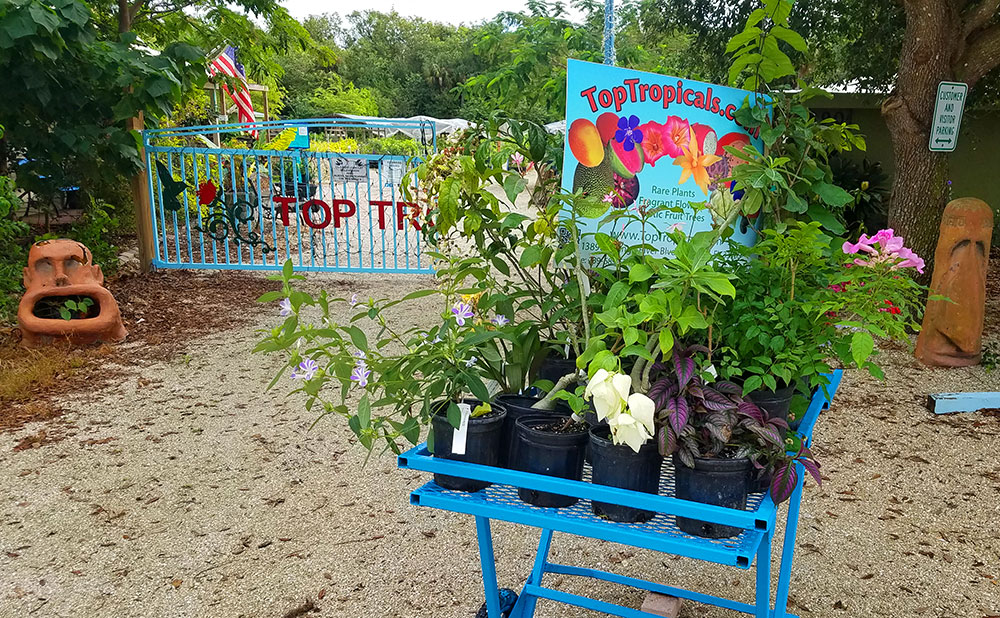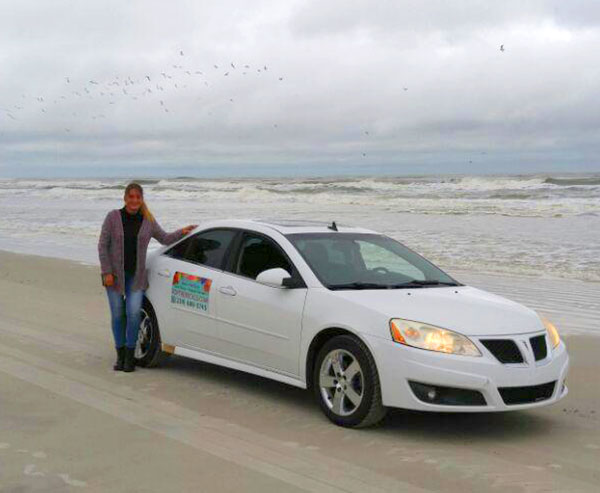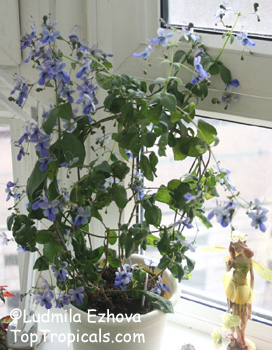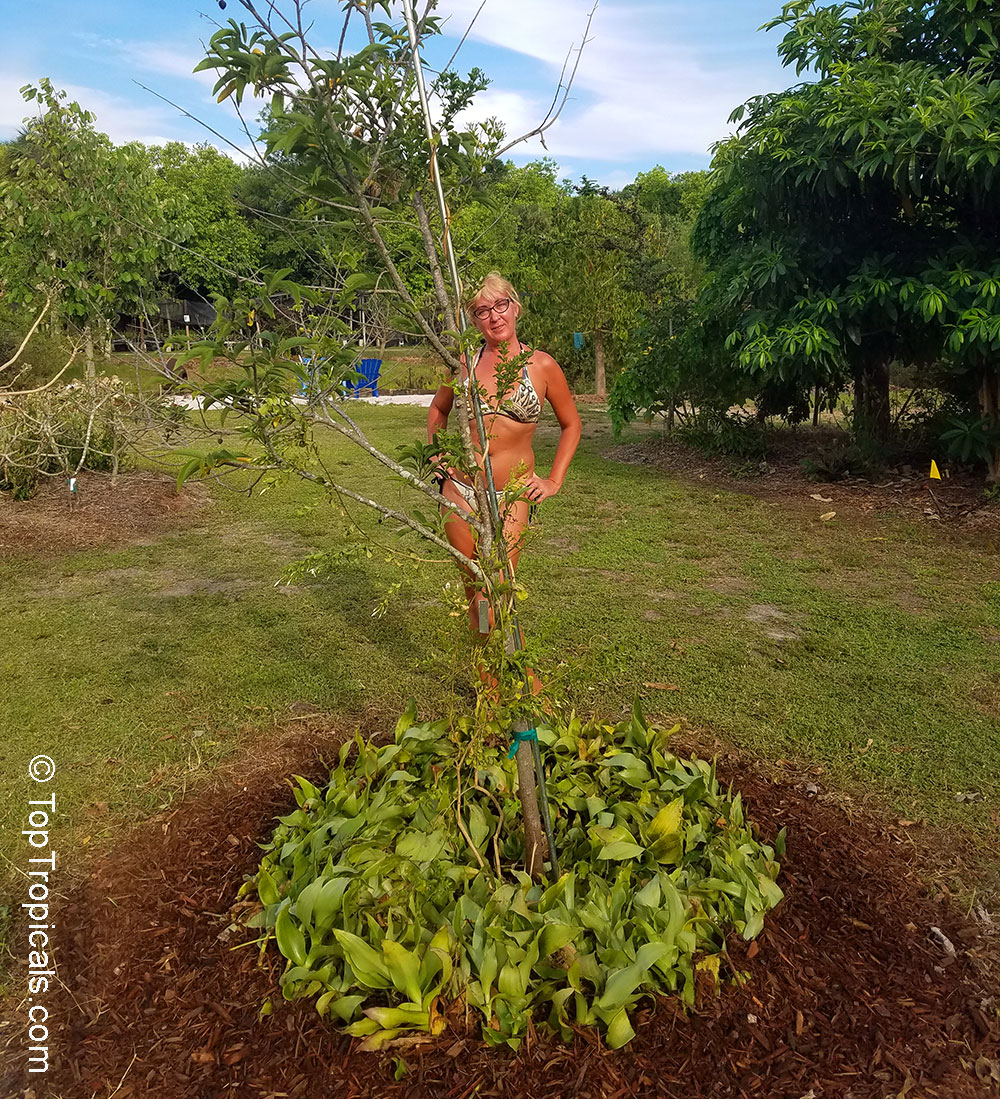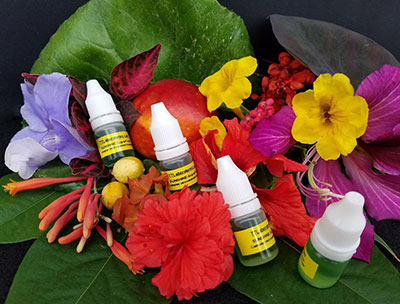Garden Blog - Top Tropicals
Date:
Our honest advise on Holiday Gift Plants
Q: Any suggestions on gift plants? With Holidays around the corner, I've been thinking of getting a present for my grandma, she lives in FL and is an experienced gardener. I also have a friend that lives in CA, also warm climate, but she doesn't have a green thumb. Any "easy" plants I can try for her?
A:
Live plant is a perfect gift, as we all know. However when
ordering a plant online as a present, for a happy
experience, you should have three things to consider:
1) Gardener's experience. Planting instructions are
included with every order, and usually success is there if
you follow them. But all plants go through shipping stress
(some more, others less) and need time, patience and love
to recover. Also, a plant will need a new home after
shipping: a pot and a good soil mix. It would be wise if
you add potting mix with a gift
order; the plant should be planted in a permanent pot as
soon as possible, but normally can wait a day in a packing
bag until its new owner gets a pot, if it is not ready
yet.
2) How easy the plant is? If buying a plant for a
beginner, chose something easy, as well as showy. Adeniums - Desert Roses, Jasmines, Clerodendrums, Cordylines are always a good
choice. Calatheas, Gingers and
Heliconias are always showy, even when not in bloom.
Spice trees and herbs are
fun, easy to grow and one can enjoy their aroma right away
without waiting on them growing bigger. Miracle Fruit is an awesome
present, it comes with detailed instructions how to grow
the Miracle!
3) How easy the plant ships? Some plants can be
easy in cultivation, but they don't take shipping well.
After being in a dark box for a few days, most plants
usually recover well in experienced hands. When making a
present, you want something showy, not just a stick to
arrive. Besides Adeniums and Jasmines, many fruit trees
usually take shipping without a problem - such as Mango or Sapote trees. You may not
want to start with Avocado, Papaya, Carambola, or Cacao - unless they go to
an experienced grower - these may take some time and skill
to etanblish. Fig trees are super easy in
shipping, but figs may drop leaves in Winter - for this
same reason, you may think twice about deciduous plants
like Sugar Apples, Grapes, Mulberries or Persimmons to be sent as
gifts. On the other hand, if you are sending a deciduous
tree to a gardener who can appreciate the variety, this
may be a good choice - dormant plants take shipping with
less stress!
Holiday special: On the picture: Adenium Xmas Santa. A Holiday Special Desert Rose with Christmas-colored flowers - deep-red and white.
Still not sure which plant to choose? You may buy a Top Tropicals Gift Certificate, it ships well and has no expiration date!
Date:
Tour of Top Tropicals - Part 2 - Nursery
Visit Top Tropicals nursery and see
spectacular flowering plants and tropical fruit trees in
pots that we ship to you.
This is the second video of a 3-part story about Top
Tropicals. The
showed some of our
garden specials.
Make sure to get back soon to see -
Part 3: Meet customer service team and shipping department
crew...
Stay updated with TopTropicals Videos by subscribing to our channel at YouTube.com/TopTropicals and get our latest video news of what is fruiting and blooming!
Date:
Winter Flowering Plants
Take advantage of the late season tropicals! Brighten up your winters with spectacular flowers and winter producing fruit trees!
Many Floridians move up North during hot summer months,
our snow-bird season usually starts late September and
ends by Mother's Day in May. Many of our local seasonal
customers planting those flowering and fruiting species
that they can fully enjoy while staying in Florida. Below
you will find a few specials that are in bloom right now.
Check out full list of winter bloomers and
late season plants, and download a PDF chart of the most
interesting tropical plants that will flower and fruit for
you in Fall, Winter and early Spring. Some of them are
ever-blooming, others are late- or early season.
Visit our Garden Center in Ft Myers FL
and see those blooming specials right now at our front
office display!
Date:
Florida winters and gardening
From
Anna Banana, our Garden Center customer advisor.
Cool weather - no sweat. Here in Florida we are
blessed to have warm winters. We just went to the beach
for Christmas! Winter time is not only a good beach time,
but also the best planting time here. Why? I always refer
my customers to Murray Corman's article Tropical Planting Breaks the
Rules. "...Wintertime does not just mean hard work
for tropical gardeners. It is also a time to enjoy the
fruits of our labor. Winter-blooming plants and the
visitors they attract - birds, bats and butterflies - make
the garden as enjoyable in winter as any other time of
year. Tasks performed during the spring and summer up
north have to be done during the fall and winter here.
Why? The answer is elementary: It's too hot! Taking
advantage of the coolest months of the subtropical year
for heavy chores like planting trees has a twofold
benefit: The gardener can make hay while the sun shines
without getting heat stroke and the plants appreciate the
moderate temperatures, enjoying a break from the stress of
93 degrees in the shade..."
Continue reading...
Winter flowering plants - are a blessing for a tropical gardener. See below what's blooming now! See our recommendations for winter flowering and fruiting plants (PDF).
Date:
How much water?
Q: I have purchased many tropical plants from you throughout the summer and now I need to think about how not to kill them overwintering in my NY apartment. I was told that overwatering can be a big problem for house plants in winter. How much should I water, and how many times per week?
A:
Overwatering in the number one cause of the houseplant
death. But be sure not to underwater, either.
- Don't water on the fixed schedule, get to know
your plant's needs instead. Most plants only need watering
when the top 1/2" of potting mix is try. gently poke your
finger into the soil to test it. Some experience gardeners
go by weight of the pot - a very light pot will have a dry
mix.
- Aim to make the potting mix moist, but not wet.
Most plants hate sitting in soggy potting mix, so always
let excess water drain away.
- Potting mix in terra cotta pots dries out more
quickly than that in plastic or ceramic pots,
because terra cotta is a porous material.
- Most plants need less water in winter because
they are not actively growing and need this period of
winter rest. However some plants are winter bloomers and they may
need regular watering providing bright light to produce
flowers, for example clerodendrums.
Date:
Overwintering tropicals indoors and air humidity
Q: My rainforest plant collection thrived outdoors in our humid summer (I live in Maryland) but of course I had to bring them indoors for winter and now with snow outside they are suffering. Some leaves dried and fell of. Please advise how not to lose my babies over winter!
A:
When overwintering tropical plants indoors, think about 3
factors: light, temperature, and humidity.
Light. Providing bright light is obvious, and all
indoor gardeners are doing their best to have as much
well-lit spots for their plants as possible.
TemperatureTropical plants, especially those from
rainforest, do not enjoy significant fluctuations in
temperature, so avoid following places: - neat hear
register (or air conditioning vent) - in drafts - on a
windowsill behind curtains at night
Humidity. Most tropical plants need more humidity
than is available in the average, centrally heated home,
but some rooms, such as bathrooms and kitchens, are more
humid than others. To created humidity, fill a tray that
is the same width as a plant, with pebbles or gravel. Pour
in water, keeping the level at just below the top of the
pebbles, then place your plant on top. The water will
produce humidity as it evaporates. Alternatively, mist the
leaves using a hand mister in the morning, so leaves dry
before night. If you have hard water, use distilled or
rain water. Grouping plants together will also increase
humidity.
Date:
Winter mulching in Southern landscapes
"My rule of green thumb for mulch is to double my initial estimate of bags needed, and add three. Then I'll only be two bags short." (Author unknown)
Q: What is the best time for mulching in Florida? What type of mulch do you recommend and how much should I use?
A:
Every gardener knows that spreading mulch in the garden
helps to protect the soil in general, prevents weeds from
growing, plus it has specific benefits during harsh winter
conditions. A layer of mulch will keep the soil insulated,
roots protected from possible freezing, so you'll also end
up with better results in spring by laying down mulch in
the cold months.
When? We lay mulch in our Florida garden right
now. It is cool so we work twice more efficient. After
rainy summer-fall season, most of mulch around plants had
broken down and in many areas soil is exposed: easy target
for weeds.
In general, in warm climates Fall and Winter mulching is
the most effective. Mulch creates an insulating barrier
between the soil and air, thereby protects plant roots
from rapid fluctuations in soil temperature.
How much? There is never too much mulch. Just make
sure to put it 2-3 inches away from the trunk to prevent
rotting and mold.
What kind? Different types of mulch can be used,
including wood chips, shredded leaves, straw and hay. Yes,
leaves and hay too! Remember all green parts of a plant (=
your leaves and grass) are full of Nitrogen so important
for plant vigor, it eventually will go back into the soil
as extra benefit. Unless you want to spend a fortune on a
fancy red or cypress mulch, you may use these natural
materials that are handy in every garden. After raking
leaves, pile them up and in couple weeks of drying and
breaking down leaves will become a perfect, soft mulch
that is best to use around fragile and herbaceous plants.
After mowing your lawn, save the cut grass and use the hay
as mulch. It always works the best in our garden, keeps
weeds away better than wood chips, and in spite of a
common belief that cut grass is full of weed seeds, we
never seen grass or weeds sprouting from that hay.
Happy mulching and stay warm!
Date:
"Happiness held is the seed; Happiness shared is the flower." (John Harrigan.)
Q: Our growing season is very short so I decided to start some of tropicals from seed indoors. When should I start?
A:
It is always a good time to start from seed. If you want
to feel happier, get into gardening. If you want to feel
God, start plants from seeds and watch New Life grow from
a tiny grain.
Traditionally, people prefer sowing seeds in Spring,
especially temperate species for vegetable garden:
tomatoes, peppers, cucumbers... My grandmother up North
started them in early Spring in small pots on a
windowsill, then once the temperatures raised just above
freezing, she planted them out in garden beds, and that
early start always helped her to have the best early
harvest in the neighborhood.
When we deal with tropical plants, "just above freezing"
is not warm enough. Which means, you have to grow small
babies indoors for quite a while, providing additional
heating when needed. Heating pads always work best... When
we had large size monitors and TV's, I always put couple
trays on top of hot monitors, and even on warm top of a
refrigerator, if space by the radiator was all taken. But
that was in very cold apartment...
If you keep your living space around 75F (ideal for many
species), this is a perfect temperature to get your seeds
started. Tropical plants are not like annual tomatoes that
try to grow through the season as fast as possible. They
may take time. So the sooner you start, the more chances
to get small seedlings just in time when Spring air
outside is warm enough - at least in 70's.
A great advantage of starting tropical seeds indoors is
controlled temperature and moisture. In the plant world,
environment extremes are not good for germination process.
Mild conditions of your home or a greenhouse create better
chances for successful growth. Seeds won't get overheated
in hot Summer sun, and won't get rotten because of a
sudden heavy rain. Just keep in mind that some species
require light for good germination.
Conditions for the best seed germination:
- Soak seeds for a few hours. Adding a few drops of Sunshine Seed Germination booster
is very beneficial and improves germination rate by 30-50%
- Well-drained mix, you may use our Professional Seed Germination Mix.
Put seeds not too deep (1/2 inch deep or less) to allow
air circulation
- Keep warm (75-85F) and in bright light
- Keep soil slightly moist but not soggy.
See more info on seed germination
Check out our seeds selection.
Date:
January 24 is Global Belly Laugh Day!
"Humor is laughing at what you haven't got when you ought to have it." (Langston Hughes)
January 24 is Global Belly Laugh Day! Celebrate the Great Gift of Laughter, smile, throw your arms in the air and laugh out loud. Laughs and smiles are sunshine that transform our moments 24 hours a day, on the 7 continents! Let's honor this week's high-spirited holiday by celebrating the chuckle.
To make you laugh and smile even more, here is a 15% off
your entire purchase!
use
this code: LAUGH2018
Offer expires end of Thursday, January 25. Min order $50
before S&H.
Laugh, get what you want and get it shipped to you for FREE!
Date:
New 2018 release: SUNSHINE SuperFood
"Two out of every five people on Earth today owe their lives to the higher crop outputs that fertilizer has made possible." (Bill Gates)
Micronutrient Supplement and Plant Health Booster
Misshapen, small fruit or no fruit?
Poor root growth?
Pale or yellow leaves?
Die backs?
Curled leaves?
Slow growth?
Don't let your plants starve... SUNSHINE SuperFood is your
answer to all these problems!
Read more why your plants need
SUNSHINE-SuperFood - Essential Element Complex that
has them all: N-NH2, Mg, Fe, Mn, Zn, Cu, B, Mo, S...
SUNSHINEâ„¢ SuperFood is a revolutionary new product
released in 2018. It is a super micro-element supplement
(Amino Acid Chelated Micronutrient) containing
microelements, ultra-microelements, glycinates, as well as
SUNSHINE-Honey ingredients.
It shows amazing results in plant development, treating
different element deficiencies, and improving fruit trees
production.
GREEN-EARTH-ECOLOGY FRIENDLY! And it is GREEN color!
Buy SUNSHINE Superfood... item # 6000!
